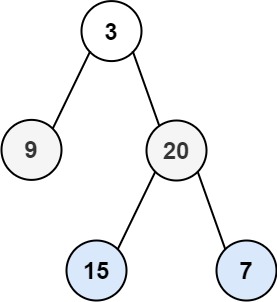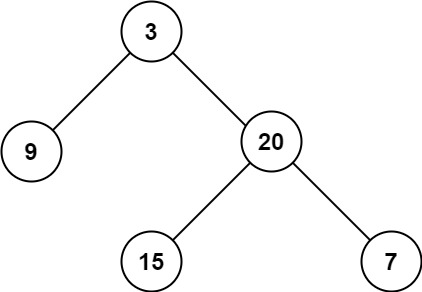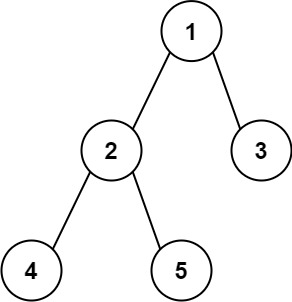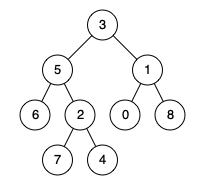Part2
Level order Traversal
Example:

Input: root = [3,9,20,null,null,15,7]
Output: [[3],[9,20],[15,7]]
🧠:
BFS
class Solution:
def levelOrder(self, root: Optional[TreeNode]) -> List[List[int]]:
res = []
if not root:
return res
queue = [root]
while queue:
curr = []
for _ in range(len(queue)):
node = queue.pop(0)
curr.append(node.val)
if node.left:
queue.append(node.left)
if node.right:
queue.append(node.right)
res.append(curr)
return res
func levelOrder(root *TreeNode) [][]int {
res := [][]int{}
if root == nil {
return res
}
queue := []*TreeNode{root}
for len(queue) > 0 {
curr := []int{}
n := len(queue)
for range n {
node := queue[0]
queue = queue[1:]
curr = append(curr, node.Val)
if node.Left != nil {
queue = append(queue, node.Left)
}
if node.Right != nil {
queue = append(queue, node.Right)
}
}
res = append(res, curr)
}
return res
}
Height of Binary Tree
Example:

Input: root = [3,9,20,null,null,15,7]
Output: 3
class Solution:
def maxDepth(self, root: Optional[TreeNode]) -> int:
if not root:
return 0
return 1 + max(self.maxDepth(root.left), self.maxDepth(root.right))
func maxDepth(root *TreeNode) int {
if root == nil {
return 0
}
return 1 + max(maxDepth(root.Left), maxDepth(root.Right))
}
Diamter of Binary Tree
Example:

Input: root = [1,2,3,4,5]
Output: 3
Explanation: 3 is the length of the path [4,2,1,3] or [5,2,1,3].
class Solution:
def diameterOfBinaryTree(self, root: Optional[TreeNode]) -> int:
self.res = 0
self.helper(root)
return self.res
def helper(self, node):
if not node:
return 0
lh = self.helper(node.left)
rh = self.helper(node.right)
self.res = max(self.res, lh + rh)
return 1 + max(lh, rh)
var res int
func diameterOfBinaryTree(root *TreeNode) int {
res = 0
helper(root)
return res
}
func helper(node *TreeNode) int {
if node == nil {
return 0
}
lh := helper(node.Left)
rh := helper(node.Right)
res = max(res, lh+rh)
return 1 + max(lh, rh)
}
Balanced Binary Tree
❓: Given a binary tree, determine if it is height-balanced
A height-balanced binary tree is a binary tree in which the depth of the two subtrees of every node never differs by more than one.
class Solution:
def isBalanced(self, root: Optional[TreeNode]) -> bool:
self.res = True
self.helper(root)
return self.res
def helper(self, node):
if not node:
return 0
lh = self.helper(node.left)
rh = self.helper(node.right)
if abs(lh - rh) > 1:
self.res = False
return 1 + max(lh, rh)
var res bool
func isBalanced(root *TreeNode) bool {
res = true
helper(root)
return res
}
func helper(node *TreeNode) int {
if node == nil {
return 0
}
lh := helper(node.Left)
rh := helper(node.Right)
if abs(lh-rh) > 1 {
res = false
}
return 1 + max(lh, rh)
}
func abs(n int) int {
if n < 0 {
return -n
}
return n
}
LCA
Example:

Input: root = [3,5,1,6,2,0,8,null,null,7,4], p = 5, q = 1
Output: 3
Explanation: The LCA of nodes 5 and 1 is 3.
🧠:
1. Return None or Node in every recusive call for both left and right childs.
2. If both left and right recursive calls is not None, then current node is your answer.
class Solution:
def lowestCommonAncestor(
self, root: "TreeNode", p: "TreeNode", q: "TreeNode"
) -> "TreeNode":
if not root or p is root or q is root:
return root
left = self.lowestCommonAncestor(root.left, p, q)
right = self.lowestCommonAncestor(root.right, p, q)
if None in (left, right):
return left or right
return root
func lowestCommonAncestor(root, p, q *TreeNode) *TreeNode {
if root == nil || p == root || q == root {
return root
}
left := lowestCommonAncestor(root.Left, p, q)
right := lowestCommonAncestor(root.Right, p, q)
if left == nil {
return right
}
if right == nil {
return left
}
return root
}
Check if two trees are identical or not
class Solution:
def isSameTree(self, p: Optional[TreeNode], q: Optional[TreeNode]) -> bool:
if p is None:
return q is None
if q is None:
return p is None
return (
p.val == q.val
and self.isSameTree(p.left, q.left)
and self.isSameTree(p.right, q.right)
)
func isSameTree(p *TreeNode, q *TreeNode) bool {
if p == nil {
return q == nil
}
if q == nil {
return p == nil
}
return p.Val == q.Val && isSameTree(p.Left, q.Left) && isSameTree(p.Right, q.Right)
}
Zigzag Level Order Traversal
Example:

Input: root = [3,9,20,null,null,15,7]
Output: [[3],[20,9],[15,7]]
🧠:
1. Use BFS
2. Use zig_zag flag at every level to zig zag the iteration.
class Solution:
def zigzagLevelOrder(self, root: Optional[TreeNode]) -> List[List[int]]:
res = []
if not root:
return res
queue = [root]
zig_zag = 1
while queue:
curr_level = []
for _ in range(len(queue)):
curr_node = queue.pop(0)
curr_level.append(curr_node.val)
if curr_node.left:
queue.append(curr_node.left)
if curr_node.right:
queue.append(curr_node.right)
res.append(curr_level[::zig_zag])
zig_zag *= -1
return res
func zigzagLevelOrder(root *TreeNode) [][]int {
res := [][]int{}
if root == nil {
return res
}
queue := []*TreeNode{root}
zig_zag := 1
for len(queue) > 0 {
n := len(queue)
curr := []int{}
for range n {
top := queue[0]
queue = queue[1:]
curr = append(curr, top.Val)
if top.Left != nil {
queue = append(queue, top.Left)
}
if top.Right != nil {
queue = append(queue, top.Right)
}
}
if zig_zag == -1 {
slices.Reverse(curr)
}
res = append(res, curr)
zig_zag *= -1
}
return res
}
Boundary Traversal
❓: Given a Binary Tree, perform the boundary traversal of the tree. The boundary traversal is the process of visiting the boundary nodes of the binary tree in the anticlockwise direction, starting from the root.
Example:
Input:Binary Tree: 1 2 7 3 -1 -1 8 -1 4 9 -1 5 6 10 11
Output: Boundary Traversal: [1, 2, 3, 4, 5, 6, 10, 11, 9, 8, 7]
🧠:
1. Result is - root + left boundary excluding leaves + leaf nodes + reversed right boundary excluding leaves
2. Edge case - If root is leave node, return [root value]
class Solution:
def traverseBoundary(self, root):
# edge case: if root is leaf node
if root.left is None and root.right is None:
return [root.data]
return (
[root.data]
+ self.get_left_boundary(root.left)
+ self.get_leaves(root)
+ self.get_right_boundary(root.right)[::-1]
)
def get_left_boundary(self, node):
res = []
while node:
if not (node.left is None and node.right is None):
res.append(node.data)
if node.left:
node = node.left
else:
node = node.right
return res
def get_right_boundary(self, node):
res = []
while node:
if not (node.left is None and node.right is None):
res.append(node.data)
if node.right:
node = node.right
else:
node = node.left
return res
def get_leaves(self, node, leaves=[]):
if node.left is None and node.right is None:
leaves.append(node.data)
if node.left:
self.get_leaves(node.left)
if node.right:
self.get_leaves(node.right)
return leaves
